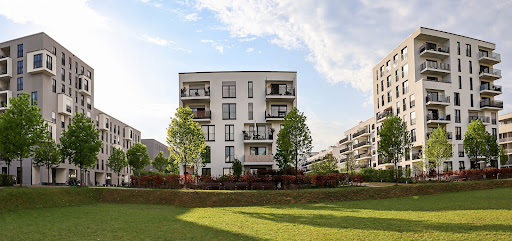
Condominiums and single-family homes or townhouses have a lot of differences, but it’s not just the vertical and horizontal orientation that is different. These communities also differ in the amount of HOA fees they charge. Condo fees are typically much higher than the average homeowners association fees. Moreover, condos use them for more than just upkeep.
What is a Condominium?
Condo fees differ because condominium complexes work differently than regular subdivisions with single-family homes, townhomes, or duplexes. What is a condominium exactly? Simply put, a condominium is a private residential building with multiple units. Each unit is sold separately to buyers for residential purposes.
Apart from dwelling spaces, condominium owners share common amenities such as gyms, co-working spaces, and swimming pools. The condominium owners pay various contractors and staff to maintain these facilities. Condominiums are a popular choice because they offer a wide range of amenities.
Conversely, unlike other planned communities, condominium owners often share other elements like plumbing, electrical, and HVAC systems.
What is an HOA Community?
Homeowners association communities, unlike condominiums, are developed horizontally. HOA communities consist of several single-family homes on a large plot of land. Like condo associations, HOAs may have shared spaces and amenities like clubhouses, pools, and tennis courts.
In addition, HOAs often have community rules that govern property use and maintenance obligations. The homeowners must abide by a certain maintenance standard, or they will be penalized. HOAs also have strict rules about where to park their cars, what decorations they can put up, and what architectural changes they can or cannot make.
What are Condo Fees for?
Condominium complexes require a lot of upkeep. Not only do condos have recreational facilities like gyms or pools, but they also have tons of shared spaces. These include condominium hallways, balconies, patios, roof decks, elevators, staircases, and even parks. Condominiums also have shared roofs, pipes, electrical wiring, and HVAC systems. Condo fees are the charges unit owners pay for all of the condo building’s maintenance.
Additionally, condo fees pay for all of the condo’s operations. Condos could not operate without security, cleaning, and administrative staff. They also require insurance and access to trash disposal, snow removal, and sewage or water services. Moreover, some condos provide shared utilities like internet, heating, and air conditioning.
Finally, condo associations in California are required to conduct reserve studies to set aside funds for emergencies and major repairs. Condo association boards divide the burden among all the unit owners so everyone contributes to the reserve funds.
Condo Fees vs HOA Fees: Breaking Down the Differences
What makes condo fees different from HOA fees? Here are the key factors that set them apart.
1. Different Ownership Structure

Condominium owners own their units individually and have joint ownership over the common elements. In contrast to condos, homeowners in an HOA individually own their units, but the one that owns the common areas is the association itself.
While HOA fees help maintain HOA property, condo fees support common property. This difference in ownership explains why condo association fees are different.
2. Higher Fees
The average condo association fee is much higher than that of regular associations because condo owners must pay to repair the entire building in addition to the common areas. On the flip side, homeowners associations only need to pay to maintain shared spaces like roads, sidewalks, and amenities. The homeowners are left to take care of their own homes.
3. Division of Assessments
Homeowners associations divide assessments equally among all homeowners. They all have equal access to the community’s facilities and shared spaces. The only exception is usually when a few homeowners have exclusive access to limited common areas. Meanwhile, condo associations follow a different system to compute assessments.
Condo associations do not always split the costs evenly among all the unit owners. Members with larger units often have larger ownership over the common elements. As a result, they may pay higher condo association fees because they have bigger responsibilities.
4. Coverage

Condo associations charge fees for various reasons. They typically cover the following:
- Maintenance of common facilities and recreational amenities like lounges, courtyards, and swimming pools
- Landscaping within and around the grounds
- Maintenance of the building’s exterior walls, roads, and roofs
- Provision of services like wastewater management, recycling, and security
- Parking lot maintenance
- Master insurance policy
- Staff salaries
- Reserve fund allotment
- Utilities like heating, air-conditioning, and internet
While homeowners association fees cover similar things, their amenities, and shared spaces are often different. HOA common areas usually include walking trails, parks, clubhouses, and roads. Additionally, while many offer services like trash disposal and snow removal, only some will cover security and utilities.
How Much are the Average Condo Fees in California?
The average condo HOA fees in California range between $300 and $400 monthly. However, some condo associations may charge much higher fees depending on the number of units, amenities, and common elements. The condo’s location and its services also play a role in determining the fee amount.
If a condo is located in an accessible area or with a higher cost of living, they may charge higher condo fees. Similarly, condos with better or more luxurious amenities typically charge more.
Apart from these, condo fees depend on the association’s financial health. Financially healthy condo associations can afford slightly lower fees if they have other income streams or enough money in the reserves. Meanwhile, condos with poor financial management may suffer from constant fee increases and special assessments.
What is a Condominium Special Assessment?
Condo associations levy monthly fees to cover the cost of operations. When the money they’ve collected is not enough, the board may charge a condo special assessment.
Special assessments are often used to cover the cost of operations that normal fees could not cover. The board may also levy special assessments if the association needs more reserves to cover repairs from natural disasters or emergency maintenance.
Additionally, some condos charge special assessments to cover the cost of unexpected litigation. For example, one of the unit owners may file a lawsuit against the board for what they think is an unfair violation notice. Legal battles are not only long but also costly. The board may end up levying a special assessment if they do not have enough money to pay legal fees.
What are Condo Fines?
Both homeowners associations and condominium associations have rules about property use and conduct. One main way associations enforce the rules is by levying fines. After all, unit owners are less likely to break the rules if they know they have to pay money for a violation.
Condo fines are the condo equivalent to HOA fines. However, most condo associations have fewer rules regarding property use and architectural improvements. Hence, they may not use fines as often as homeowners associations. Regardless, unit owners can review their governing documents—particularly the CC&Rs and bylaws—to understand how and when the association may levy fines.
It’s important not to confuse fines with fees. Fines are charges levied only because of violations. Meanwhile, fees are monthly charges everyone has to pay to maintain the condo building. Unit owners must pay both, but they differ in purpose, amount, and frequency.
Why do Condos Charge Fewer Fines Than HOAs?
Unlike homeowners associations, condominiums have little room for exterior architectural changes. Unit owners rarely redesign their condo exteriors because they only face long hallways. Meanwhile, homeowners can get more creative when decorating or outfitting their homes in a single-family or townhome community.
In addition, homeowners in HOAs have more to maintain. They must mow their lawns and ensure their fence and home exterior paint are in good shape. They may be penalized if they do not maintain these according to the HOA’s standards. On the other hand, condo unit owners have less to maintain in their exterior.
Frequently Asked Questions
Can Condo Fees Increase?
Yes, condo association fees can increase if necessary. California law requires fee increases to be approved by a majority vote if they are above a certain percentage.
Do Unit Owners Need to Pay the Fees?
Yes, condo owners must pay their association fees. The fees are legally binding upon the unit owners the moment they purchase a unit from a condo association.
Understanding Condo Fees
Many people assume that HOA and condo fees are the same. However, they differ in many ways. Homeowners can expect to pay much more when living in a condo. Due to the shared nature of their infrastructure, condominiums have much more ground to cover and offer more services.
Personalized Property Management provides a wide array of condo management services to condominium associations in Southern California. Call us at 760-325-9500 or leave us a message.
RELATED ARTICLES:
